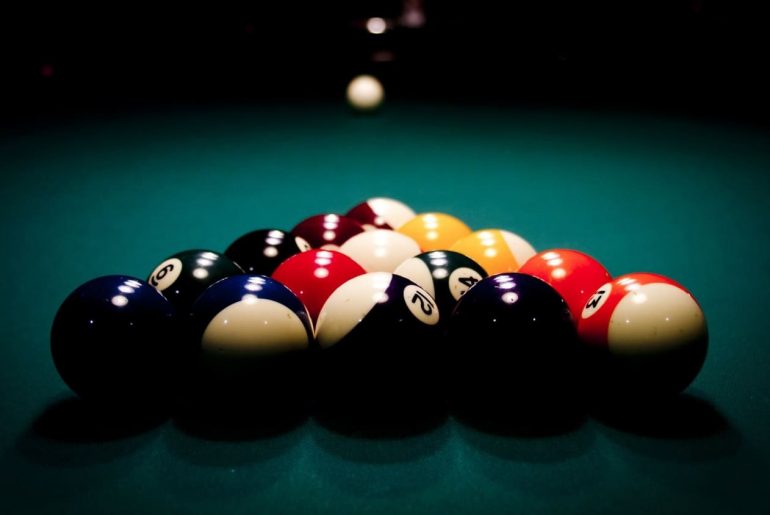Would you like to play billiards, but don’t know the billiard rules yet? No problem, with us you will find everything you need to know about this great game!
Billiards coming soon
In billiards or a game of billiards, two people or two teams compete against each other. A special billiard table, billiard balls or balls and a wooden stick or cue are required for each player. The balls are moved by bumping, but the player with the cue may only bump the cue ball or cue ball. This playing ball in turn pushes other balls (object balls). The aim of the game is to sink all object balls faster than the opponent into the designated holes on the billiard table.
The French word bille (ball) was probably the inspiration for the name of the game. The earliest mention of a billiard table at the court of the French King Louis XI. can be dated to 1470. By the mid-16th century, billiards was an established pastime in many of Europe’s royal houses and part of social life. Around 1850, the first sets of rules were created, the first forms of player organization and the first championships were held in tournament form. Especially in Great Britain and in the USA the interest in the game of billiards was great. While billiards developed into a professional sport in the USA, Europe remained amateur.
Around 1880, all billiard variants that are common today were already established and some were further developed with new sub-variants. Of all the possible variants of the game, pool is the most common and most of the pool tables open to the public are built for pool.
Equipment: You need this to play billiards
Pool table
The billiard table for pool billiards has a certain size and playing surface design as required by the billiard rules. The playing surface is covered with a billiard cloth made from synthetic fibers such as nylon, polyester, Teflon or Trevira. The color of many tables is dark green, but the color of the cloth can vary. The so-called bands (wood with band rubber coating), which are between 36 and 37 millimeters high, run around the playing surface.
It is subject to certain standards by the official associations:
The 8-foot table, playing surface, 2240 by 1120 millimeters, minimum weight: 300 kilograms (minimum size for championships)
The 9-foot table, playing surface, 2540 by 1270 millimeters, minimum weight: 350 kilograms (Bundesliga, German and international championships).
The 6-foot table for blackball in Bundesliga, German and international championships), ratio of 2 to 1 between length and width, the table height must be between 750 and 850 millimeters.
The outer frame or band mirror must be at least 100 millimeters wide to rest the fingers on the cue guide. There are three marks in the head and foot area and six marks along the length, the so-called diamonds, at standardized intervals. These markings help to calculate the cue throw.
There are a total of six lower pockets or perforated pockets, four corner pockets and two center pockets on the long sides for the balls. A return system for the ball return on the side or at the foot end collects all the balls that have been put in the hole below the playing level at a collection point. The cue ball is mostly thrown out at commercial tables for reuse.
Queue
A cue is the billiard stick, which can be made of either wood or plastic or aluminum reinforced with glass or carbon fibers. There are different lengths, diameters and degrees of hardness.
Each cue has a so-called tip, usually a piece of leather.
There are single-layer and multi-layer, they can be glued or screwed on. The harder it is, the easier strong impacts are. Rounding and roughening the tip of the tip serves to hold more chalk and thus allow more spin in the shot.
You can also use a cue extension as an aid for difficult shots. She puts her back on the handle of the cue. An auxiliary cue with a cross-shaped tip or the spider, an elevated auxiliary cue with an arched support at the end, may also be used.
Billiard Chalk and Reamer
The billiard chalk is applied to the bitter orange to ensure better adhesion. This chalk, usually blue in color, comes in the form of paper-wrapped cubes or cylinders about 2 centimeters in diameter.
To ensure better absorption of the chalk, there is the rasp for the bitter orange, a small steel plate with a waffle pattern. This can be used to roughen the leather at the tip of the cue.
Billiard balls
Billiard balls are made of high purity phenolic resin. Pool balls have a diameter of 57.2 millimeters and weigh 170 grams. A white cue ball and 15 object balls are used in pool billiards. These balls are numbered from 1 to 15; those 1 to 8 are called the full ones. The balls 9 to 15 are called the halves because they are only half colored. The numbers are always assigned the following colors:
1 and 9 = Yellow
2 and 10 = blue
3 and 11 = red
4 and 12 = Purple and Pink1, respectively
5 and 13 = orange
6 and 14 = Green
7 and 15 = brown
8 = Black
Cue Ball: White
Billiard Rules: How the game works
Thrusting techniques
A billiards player should keep his forearm straight when executing the stroke with the cue, there should be a right angle between the forearm and upper arm. Only the elbow should be moved to gain momentum, shoulder and wrist remain stiff.
The thrusting techniques include
an ideally elastic shot that hits the cue ball exactly in the middle, continuing a straight line
a decentralized spin that causes the cue ball to spin. This gives the ball a certain running behavior, for example for a bow shot or a return shot.
Billiard Rules
Basic billiard rules
Each player or team has 7 colored balls. The aim of the pool billiard game is to sink your own balls faster than your opponent. If a player has sunk it, the black must then be sunk in a specific hole in order to win the game. If a player pots the black ball too early or into the wrong hole, he loses the game immediately. The rules of the game are standardized and precisely defined for tournaments and championships. In the leisure sector, the billiard rules are pub rules. This means that these rules can vary slightly from pub to pub.
Gameplay
At the start of the pool game, players choose who will play which balls. Usually, the choice is made by the first ball a player pots. If it is a full one, then he plays the full billiard balls and may only pocket these.
The object balls are set up and placed in the plastic triangle. The black ball must be in the middle of the third row and there must be a full and a half in each of the outer corners.
The toast is from the top field, the first quarter of the area. The triangle lies with the apex on the head point, which is in the middle of the head line. The white billiard ball for the opening shot (break) is on the opposite foot point in the lower quarter of the table. The cue ball is shot at the ball pyramid with as much force as possible in order to spread it out as much as possible and possibly sink the first ball.
If a ball has been pocketed, the player has made the choice between a full or a half and may only play these balls.
If no ball was pocketed, it is the other player’s turn. As soon as a player has pocketed a ball, it is assigned who has to play which ball (full or half).
Billiard Rules Variants
In other variants, the opening player may place the cue ball anywhere in the headboard and play on any ball in the triangle.
Another variant of the billiard rules allows the player to choose any full or half if he also sinks colored balls in the opening shot. It doesn’t matter whether half or full balls were sunk in the face-off. Then, however, exactly the ball and the pocket must be announced for the next shot. If the player succeeds in fulfilling the announcement – sinking the announced ball into the announced pocket – he may continue the game. If all own balls are pocketed, the player may play the 8 ball. If he sinks this too, he wins the game.
Player change
The change to the other player occurs when
- a player fails to pocket a ball
- if one of the opponent’s balls is pocketed instead of one’s own ball
the white cue ball is pocketed with a ball - when the black ball is played correctly but not pocketed
- the black ball is pocketed too early before all of your own balls are pocketed, the player automatically
- loses the game.
Billiard fouls
A foul is when basic billiard rules are violated. If there are 3 fouls, a player automatically loses. Examples of fouls are:
- Short gang
- The white billiard ball must always roll at least halfway across the table. If she doesn’t, it’s a foul
- Wrong object ball
- If the cue ball first touches an opponent’s object ball instead of one’s own object ball (full or half), then that is a foul.
- ball touched
- Billiard balls in play must never be touched with hands, it is a foul.
- Ball falls off the table
- If, during a faceoff, the cue ball or any other ball falls off the table, it is considered a foul.
Resumption of play after fouls
Foul on faceoff: The opposing player can place the cue ball anywhere in the headcourt and play any ball outside of the headcourt.
Foul in play: The opposing player can place the cue ball anywhere on the table.
If colored balls fall off the table, they are placed on the foot spot if possible. If this is not possible because several balls have to be placed or the base is occupied, the balls are placed on the line between the base and the short cushion.
Billiards at home
If you want to play billiards at home, you need a lot of space. How big this should be depends on the size of your table.
| table size | Recommended minimum room size |
| 8 feet | 425cm x 315cm |
| 9 feet | 455cm x 330cm |
The main reason for the large room dimensions is the cue, because you need space at the back to be able to use it!
By what other names is billiards known?
Other names for the popular “pub game” are: pool billiards, snooker, but also carom, Russian or English billiards and bowling billiards.
What is the name of the billiard balls?
The classic names are “billiard balls” or billiard balls.
What is the difference between the billiard balls?
The billiard balls are divided into two categories: those that you are allowed to touch with your cue and those that are not. The colors make the statement about which discipline you play.
What is the difference between snooker and pool?
The difference lies in the size of the table and balls: the snooker table is twelve feet long by six feet wide by nine feet KL. The snooker balls have a smaller diameter.
What role does the 8 ball play in billiards?
The task of the number 8 black ball is to end the game. Either because she is the last ball on the table or because a foul is initiated in which she has a hand.
How many balls are there in billiards?
You play pool billiards with 15 balls plus the white and black ones. You play snooker with 21 balls.
How do you hold the cue correctly?
To hit a ball you need the cue. You place this between your thumb and forefinger so that it “slips through” when you give it a push with your other hand, which you position at the back.
Why do some people get black billiard ball tattoos?
The ball has become a symbol of risk taking and destiny. In billiards language, this means: Every player is aware of the premature end of a thing if the black ball is not pocketed last.
When was billiards invented?
The earliest recorded playing of a recognisable form of billiards was in France in the 1340s. Played as an outdoor lawn game similar to croquet, it eventually moved indoors and onto a wooden table with green cloth to resemble grass on which it had been previously played.
How to clean billiard balls
Is billiards a sport?
Billiards is a sport, and you can play different games within the sport: eight- ball, nine- ball, three ball, one pocket and bank pool. Pocket Billiards has been declared a Sport by the Olympic Committee.





